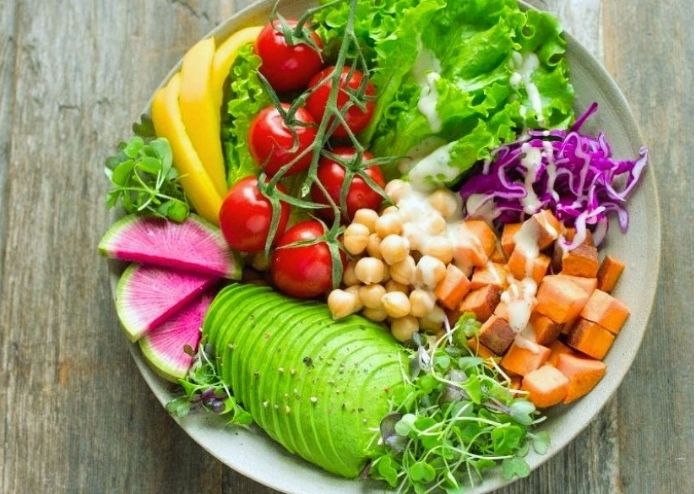Raw food has long since shed its dusty image of the eighties. When sustainable, purely plant-based food is booming, natural foods à la raw food are being re-staged.
If you think of raw food sticks, you are not wrong, but the food trend has much more. From beetroot carpaccio with rocket pesto to Buddha bowls, something for every taste is served on request in hip city restaurants.
What Is Raw Food?
As an alternative form of dieting in dietetics, raw food in the narrower sense is a vegan diet. The menu consists of unprocessed, natural plant foods (raw food). In the meantime, however, there are different variants and accordingly no uniform definitions of raw food.
Some raw foodists eat purely plant-based and vegetarian – for example, with raw milk and raw milk cheese. They also eat eggs, meat and fish as long as they have not been heated above 40 degrees. While preferring raw plant foods, other natural food fans add some cooked, baked, stewed, and steamed foods to their diets.
Frozen, fermented and dried and thus quickly processed products are also “served” in the modern interpretations. These include natural olive and walnut oil as well as fresh juice. Therefore, special juice presses and dehydrators, which can produce apple or vegetable chips at reduced heat, are booming in the raw food scene.
What Does The Raw Food Diet Promise?
Bircher-Benner’s raw diet is based on the theory that plant foods store solar energy. This food, which Bircher-Benner called “sunlight accumulators”, is said to release stored energy in the human body. Schnitzer and Co. also judged their nutritional strategies to be “healing”.
How Does The Raw Food Diet Work?
If you want to try the raw food diet, you should first decide which variant suits you. The motto is: While strict forms are only temporarily useful from a nutritional point of view, raw, plant-based foods should be combined with a certain proportion of warm meals for a permanent diet. Depending on your diet, this can be vegan, vegetarian or flexitarian (plant-based with small amounts of high-quality organic meat).
Basic Principle Raw Food
The menu consists of raw and, if desired, additional foods heated to a maximum of 40 degrees. Since the enzymes in fresh food are only destroyed at a temperature of around 42 degrees, slight heating of up to 40 degrees is permitted in the raw food scene.
Raw food principle:
- The original variant is vegan
- The basis is raw vegetables, fruit & salad*
- natural foods
- at most short-term storage
- regional & seasonal organic quality is preferred
- everything is allowed that has been heated below 40 to 42 degrees
- Avoid vitamin loss through prolonged watering
- no finished products
- cool & light-protected storage
- To protect the vitamins, cut plant food just before serving
What Foods Are Allowed?
The foods allowed in the raw food diet depend on the respective definition. In the original sense, all types of fruit, vegetables, and salad have not been heated or processed.
There are also herbs, nuts, almonds, olives and natural, cold-pressed vegetable oils. The latter example shows that modern forms allow for a certain degree of processing. Therefore, honey, oatmeal, nut and almond butter and dried fruit are also on the menu.
Fermented vegetables: Due to the probiotic cultures they contain, lactic acid fermented vegetables – pickled in brine with the exclusion of oxygen – are particularly recommended. The intestinal flora and thus also the digestive function and the immune system benefit from the regular intake of small amounts of probiotics.
Suitable foods:
- unheated vegetables & salad
- Nuts & almonds (also almond butter)
- fresh fruit
- fresh grain muesli
- fermented vegetables*
- oatmeal
- unheated fruit juice & smoothies
- Mushrooms & Olives
- germinated sprouts
- avocado
- unheated vegetable soups
- Kernels & Seeds
How Balanced Is The Raw Food Diet?
Whether and to what extent a raw food diet is balanced naturally depends on the variant. Anyone who eats raw, natural plant foods, nuts, olives, and the like must put together a varied diet. In addition, he should observe the current nutritional recommendations for a vegan diet – including the supplementation of vitamin B12.
Risk Of Nutrient Deficiency
Eating a strictly raw diet can increase your risk of calcium, iodine, magnesium, iron, vitamin D, and zinc deficiencies.
Essential Amino Acids And Unsaturated Fat
It is essential to get enough unsaturated fatty acids from walnuts, olive oil, hazelnuts, avocado, chia seeds, almond butter, linseed oil, walnut oil or olives. In addition, essential amino acids (protein building blocks) in fresh grain muesli, nuts, almond butter and co. should be on the daily menu.
Flexible Raw Food
Raw food can also be flexible by adding cooked foods such as potatoes, whole grains and legumes to your diet. So the diet can be pretty balanced – and also vegan.
Also Read: Ideal Vegetables For Ketogenic Diet

